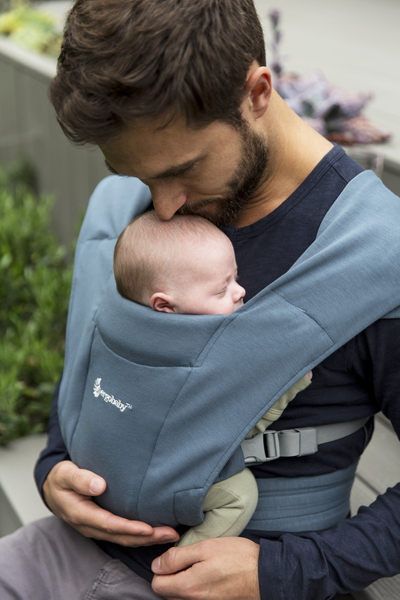
Like every new parent, your first few nights at home after labor and delivery can be quite the adventure. From learning to breastfeed to the lack of sleep, that fourth trimester can be disorienting. And although a crying baby is expected, it can be overwhelming when your baby is inconsolable. Colic is a term used to describe excessive, often unpredictable crying in an otherwise healthy and well-fed baby. It’s a source of distress for both parents and infants. In this blog post, we’ll explore the causes of colic, provide tips for soothing colicky babies, and highlight the benefits of babywearing as a helpful solution.
Understanding Colic in Babies
Colic typically starts around the second or third week of a baby’s life and may continue until around three to four months of age. The exact cause of colic remains a mystery, but it’s believed to result from a combination of factors:
- Gastrointestinal Discomfort: Some experts speculate that colic may be linked to digestive issues, such as gas or indigestion.
- Sensory Overload: Babies are constantly processing new sensory information, which can sometimes overwhelm them.
- Immature Nervous System: The nervous system of newborns is still developing, and this may contribute to increased irritability.
- Parental Stress: Babies are highly attuned to their parents’ emotions, and a stressed or anxious environment can affect their behavior.
Signs of Colic
Infantile colic is often diagnosed if a baby cries for more than three hours a day, three days a week, for at least three weeks. Other colic symptoms may include:
– Clenched fists and arching of the back
– Flushed face
– Intense, high-pitched crying
– Difficulty in soothing, even with feeding, changing, or cuddling
– Crying episodes that occur at the same time each day, often in the late afternoon or evening
How to Soothe a Colicky Baby
Caring for a colicky baby can be challenging, but there are strategies parents can try to help soothe their little ones:
1. Create a Calm Environment
– Keep the baby’s surroundings quiet and dimly lit during fussy periods.
– Use white noise machines or gentle lullabies to create a soothing atmosphere.
– Maintain a consistent daily routine to provide a sense of security.
– Sometimes even taking them outside can help soothe them from the sounds of nature and the breeze on their cheeks.

2. Gentle Massage
– Gently massage your baby’s tummy in a clockwise motion to help alleviate gas and discomfort.
– A warm bath can also be soothing and help relax a colicky baby.
– Gripe water is thought to be another helpful solution for belly pain and colicky behavior.
3. Feeding Techniques
– Ensure proper burping after each feeding to release trapped gas.
– Experiment with different feeding positions to reduce air intake.
– If breastfeeding, consider adjusting your diet to avoid foods that may cause gas in your baby.
4. Offer a Pacifier
– Pacifiers can provide comfort and help satisfy the need to suck, which can be soothing for babies.
5. Babywearing
Babywearing, the practice of carrying your baby in a sling, wrap, or carrier, has gained popularity as an effective way to soothe newborns with colic. Here’s how babywearing can help:
Babywearing: A Helpful Solution for Colicky Babies
- Skin-to-Skin Contact
Babywearing allows for constant skin-to-skin contact, which can help regulate a baby’s body temperature and reduce stress. This close physical connection promotes feelings of safety and comfort, making it an ideal solution for colicky infants.
- Mimics the Womb
Being wrapped snugly against a parent’s chest mimics the cozy environment of the womb. Babies find this position calming and reassuring, helping to reduce fussiness and crying.
- Hands-Free Parenting
Babywearing allows parents to be hands-free while still comforting their colicky baby that doesn’t seem to calm down if they’re not being held. This freedom to move and complete daily tasks can be a lifesaver for parents experiencing sleep deprivation and stress.
- Reduced Overstimulation
The world can be overwhelming for a colicky baby, with all its sights, sounds, and sensations. Babywearing provides a cocoon of security, shielding the baby from excessive stimuli and promoting calmness.
- Bonding and Attachment
Babywearing enhances the parent-infant bond by promoting closeness and responsiveness. It helps parents tune in to their baby’s cues and respond promptly to their needs, fostering a secure attachment.

Choosing the Right Baby Carrier
When considering babywearing for your colicky baby, it’s essential to choose the right carrier. Here are some tips for selecting a suitable baby carrier:
– Ergonomic Design: Opt for a carrier that supports your baby’s natural position, promoting healthy hip and spine development for them, and ergonomic comfort for you.
– Adjustable Straps: Ensure that the carrier has adjustable straps to accommodate both parents comfortably.
– Comfort for Parents: Look for a carrier that evenly distributes the baby’s weight to prevent strain on your back and shoulders.
– Age and Weight Limits: Check the carrier’s age and weight limits to ensure it’s appropriate for your baby’s size and age.
– Safety Features: Make sure the carrier has safety features like secure buckles and straps to keep your baby safe and secure.
Here’s a breakdown of the different types of baby carriers and how to wear them.
Tips for Safe Babywearing
Safety is paramount when babywearing. Follow these guidelines to ensure a safe and comfortable experience for both you and your baby:
– Always read and follow the manufacturer’s instructions for your specific carrier.
– Check that your baby’s airway is clear and that their chin is not pressed into their chest, ensuring they can breathe freely.
– Keep your baby’s face visible and close enough to kiss. You should be able to see their face at all times.
– Adjust the carrier to ensure your baby’s legs are in a spread-squat position, with their knees higher than their bottom. This promotes healthy hip development.
– Regularly inspect the carrier for any signs of wear or damage, and replace it if necessary.
Colic can be a challenging phase for both parents and babies, but remember that this won’t last forever. And as you navigate the ups and downs of colic, remember that you’re not alone, and seeking support from friends, family, or healthcare professionals can make the journey more manageable. With patience, love, and the right techniques, you can help your colicky baby find comfort and peace during this challenging phase.



